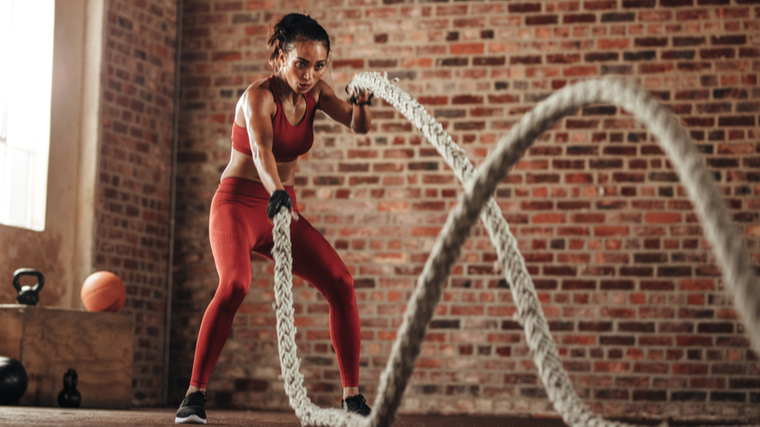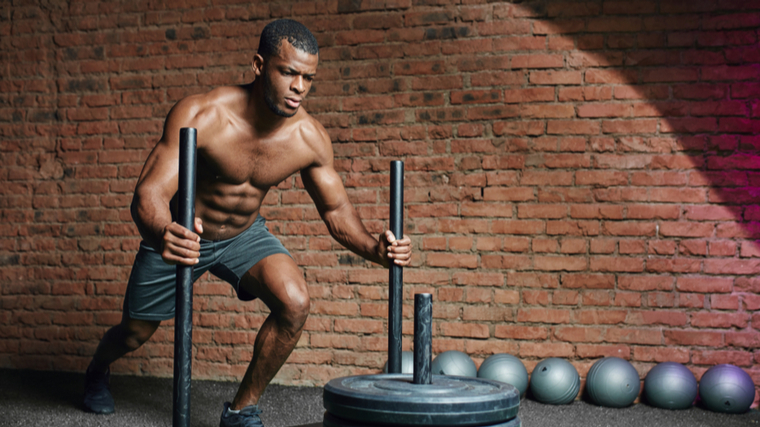Some days, you’re exhausted when you finish your last working set and feel like you can’t push any harder. Then you catch your breath, and you find that you’re ready to go again. When you get that second wind, it might be time to add a workout finisher to the end of your session.

Adding a finisher into your workout means going at a nearly all-out effort for five to 15 or 20 minutes with minimal rest. These post-strength training mini-sessions are designed to improve your conditioning and work capacity. As a result, you’ll be able to perform harder work for longer periods of time — no more getting quite as winded after an eight-rep set.
What Are Workout Finishers?
Workout finishers are micro training sessions you perform after your regularly-programmed strength training. They’re meant to be short and intense, focusing on circuit or interval training designed to get your heart rate up. For some, that might mean running sprints, while others might break out some kettlebells, sleds, or battle ropes. You can also opt for bodyweight finishers, where you focus on high-intensity moves like burpees or perform as many push-ups and pull-ups as possible in a given period of time.
Finishers are supposed to bring you to the brink of full-body failure. The idea is that if you increase the intensity of your training — after giving it your all with your barbell lifts — you can make a lot more gains in the long run. Since they’re circuit and interval-based, finishers can help you skyrocket your conditioning and work capacity. You’ll also be training your body and mind to push harder for longer.

Some studies suggest that your training tool of choice is less important than how hard you’re working. For example, metabolic conditioning is effective when using stair climbers and exercise bikes in intense intervals. (1) Research has also found that movements like kettlebell swings, thrusters, and burpees are also sufficient to improve your metabolic conditioning and strength. (2)
Another reason to add finishers to two or three workouts per week is because, well, they may actually be fun. Because finishers take a shorter amount of time than less intense work — and because your stimulus is constantly changing with the work-rest intervals — research has found that recreationally active folks often enjoy high intensity interval-style training more. (3) So if you’re looking to end your workout on a high note, finishers might be a great choice.
How Finishers Work
Research suggests that interval and circuit training after your strength workouts can boost your metabolic conditioning and make you stronger. (2) That means that finishers can help your body be able to physically process more intense workloads more efficiently. This can lead to your muscles — and lungs — being able to handle heavier loads for higher reps. When your body can safely handle more training volume and intensity, you may be able to make even more overall strength gains.

If you’re looking to be able to breathe and recover better from higher rep or heavy sets, you might want to improve your VO2 max — an important indicator of cardiovascular fitness. Finishers can help you do exactly that. By clustering short bursts of intense work so close together after your traditional lifts, you’re increasing your body’s ability to handle harder work.
That doesn’t mean that there’s only one effective way to perform finishers. They’re adaptable to multiple levels of experience and training goals. Research suggests that to start out, your high-intensity intervals can be short (less than 30 second intervals of work) and low volume (less than five minutes total). If you’re more experienced and really looking to get the most out of your end-of-workout interval training, research says that you’ll want longer intervals of work (two minutes or more) at a higher volume (15 minutes or more). (4)
Who Should Do Finishers
Even strength athletes who don’t need to perform feats of endurance or cardiovascular fitness in competition can benefit from finishers. Here are some of the ways that finishers can improve your program — yes, even for powerlifters.
Powerlifters
It’s not necessarily an untrue stereotype that many powerlifters feel absolutely breathless after completing a “high-rep” set of eight squats. And although the sport of powerlifting doesn’t technically require a high level of cardiovascular fitness, powerlifters — especially during the offseason — can use finishers to boost their work capacity. The higher your work capacity, the more training you’ll be able to complete and recover from. Ultimately, that means you can lift more weight, more efficiently. And the better you can do that, the better you can add pounds to your lifting totals.
Bodybuilders
While bodybuilders can certainly benefit from the fitness and strength benefits from traditional finishers, many bodybuilders take a more unique approach. Instead of only diving into a finisher at the end of a workout, bodybuilders might take a set-by-set finisher approach. That’s because you can think of drop sets as finishers.
Drop sets are designed to bring your muscles to absolute failure for a particular exercise. To perform a drop set, you’ll perform your usual heavier set of an exercise — say, a barbell curl — as usual. Then, you’ll immediately lessen the weight and perform another full set. Right away, you’ll drop the weight again and perform a third set to failure.

When performed with isolation exercises, these sets won’t have the same metabolic conditioning effect on you. But if your main concern is gaining muscle, integrating finishers via drop sets can be a great choice.
Functional Fitness Athletes
When you’re into CrossFit or other sports that require you to maintain a high level of functional strength and endurance, finishers can be just what you need. Even after an intense training session, they provide an added level of exertion that can boost your work capacity. You’ll up your training volume without adding a lot more time to your program — and, you’ll force your body to adapt to increased demands when you’re already fatigued from training. That way, next time you’re forcing your way through a workout of the day (WOD) or other fitness challenge, you’ll have the mental grit and physical capacity you need to finish it.
Literally Anyone Else
Even though finishers seem intense, they don’t all have to be fancy. Research suggests that you can start small — 30 second intervals or less, for five total minutes or less — and still reap big gains. (4) Especially if you’re new to the gym, you’ll be able to benefit from these short but intense post-workout sessions. They’ll teach you to maintain excellent form even when you’re tired. And in the long run, they’ll make you less likely to tire quickly. This will serve you very well as you gain more experience in the gym, especially if you want to start lifting heavier weights for more reps.
How Often to Do Finishers
Research has shown that performing exercises like 20 reps of thrusters or two to three minute intervals including double-unders, kettlebell swings, and burpees can improve people’s strength and metabolic conditioning — even if you only do these finisher-style workouts twice a week. (2)
Similarly, studies suggest that even if you’re used to training intensely three or four times a week, performing intense interval-based sessions like finishers only twice a week won’t diminish your gains. (5) This makes sense, because if you have the energy to perform a full-throttle finisher after every workout, you’re probably not pushing hard enough to begin with. So, stick to two or three finishers per week to make sure you can recover well and maintain a high level of excellence during your regular workout.
Sample Finisher Workouts
When you’re looking to add finishers to your workout, it can be tough to figure out where to start. You can choose from a wide array of activities — from box jumps and rowing intervals to burpees and barbell complexes. Here are a few examples of workout finishers that can help maximize your gains.
Battle Rope Finisher
If you’re looking for some extra variety in your program, opt for battle ropes. They’ll fire up your shoulders, upper back, core, and even your forearms. Plus, your heart rate will be thumping from your first bout onward.
If you need to rest longer between sets, feel free to tack on rest time until you build up your endurance and work capacity. As you progress in your training, consider slicing some seconds off your rest periods.
- Battle Rope Wave: 20 seconds
- Rest: 20 seconds
- Battle Rope Slam: 30 seconds
- Repeat circuit five to 10 times. Rest for 45 seconds between circuits.
Kettlebell Conditioning Finisher
The idea here is to build both strength and cardiovascular fitness. Kettlebells are uniquely suited to this task, as you’ll be performing explosive, full-body lifts with minimal rest.
View this post on Instagram
Make sure you’re paying strict attention to form. If you only have access to one kettlebell, half the work time and perform the thrusters unilaterally.
- Double Kettlebell Thruster: 30 seconds
- Double Kettlebell Swing: 60 seconds
- Alternating Kettlebell Clean: 45 seconds
- Repeat circuit three to five times. Rest for 90 seconds between circuits.
Functional Finisher
Sometimes, the most functional moves — pushing, pulling, and carrying — are the ones that get neglected most in training. This finisher is designed to increase your work capacity, improve your grip strength, and target potentially overlooked aspects of your functional fitness game.
Perform each exercise in turn with as little rest as possible.
- Unilateral Overhead Carry (Left Side): 30 seconds
- Sled Push: 15 meters
- Burpee: 10 reps
- Sled Pull: 15 meters
- Unilateral Overhead Carry (Right Side): 30 seconds
- Repeat circuit three to five times. Rest for 45 to 90 seconds between circuits.
Finish It Off
Workout finishers are time-saving, effective ways to boost your conditioning and increase your work capacity. You only need to add them to the end of your workout two or three times a week to reap the benefits of increased strength and better cardiovascular fitness. From powerlifters trying to avoid getting wiped out by a single set of eight reps to CrossFitters wanting to improve their next WOD, finishers might just be the training solution you’ve been looking for.
References
- Ito S. High-intensity interval training for health benefits and care of cardiac diseases – The key to an efficient exercise protocol. World J Cardiol. 2019;11(7):171-188.
- Feito Y, Hoffstetter W, Serafini P, Mangine G. Changes in body composition, bone metabolism, strength, and skill-specific performance resulting from 16-weeks of HIFT. PLoS One. 2018;13(6):e0198324.
- Thum JS, Parsons G, Whittle T, Astorino TA. High-Intensity Interval Training Elicits Higher Enjoyment than Moderate Intensity Continuous Exercise. PLoS One. 2017;12(1):e0166299.
- Wen D, Utesch T, Wu J, Robertson S, Liu J, Hu G, Chen H. Effects of different protocols of high intensity interval training for VO2max improvements in adults: A meta-analysis of randomised controlled trials. J Sci Med Sport. 2019 Aug;22(8):941-947.
-
Thomas G, Songsorn P, Gorman A, Brackenridge B, Cullen T, Fitzpatrick B, Metcalfe RS, Vollaard NBJ. Reducing training frequency from 3 or 4 sessions/week to 2 sessions/week does not attenuate improvements in maximal aerobic capacity with reduced-exertion high-intensity interval training (REHIT). Appl Physiol Nutr Metab. 2020 Jun;45(6):683-685. doi: 10.1139/apnm-2019-0750. Epub 2020 Feb 20. PMID: 32078337.
Featured Image: Jacob Lund/Shutterstock